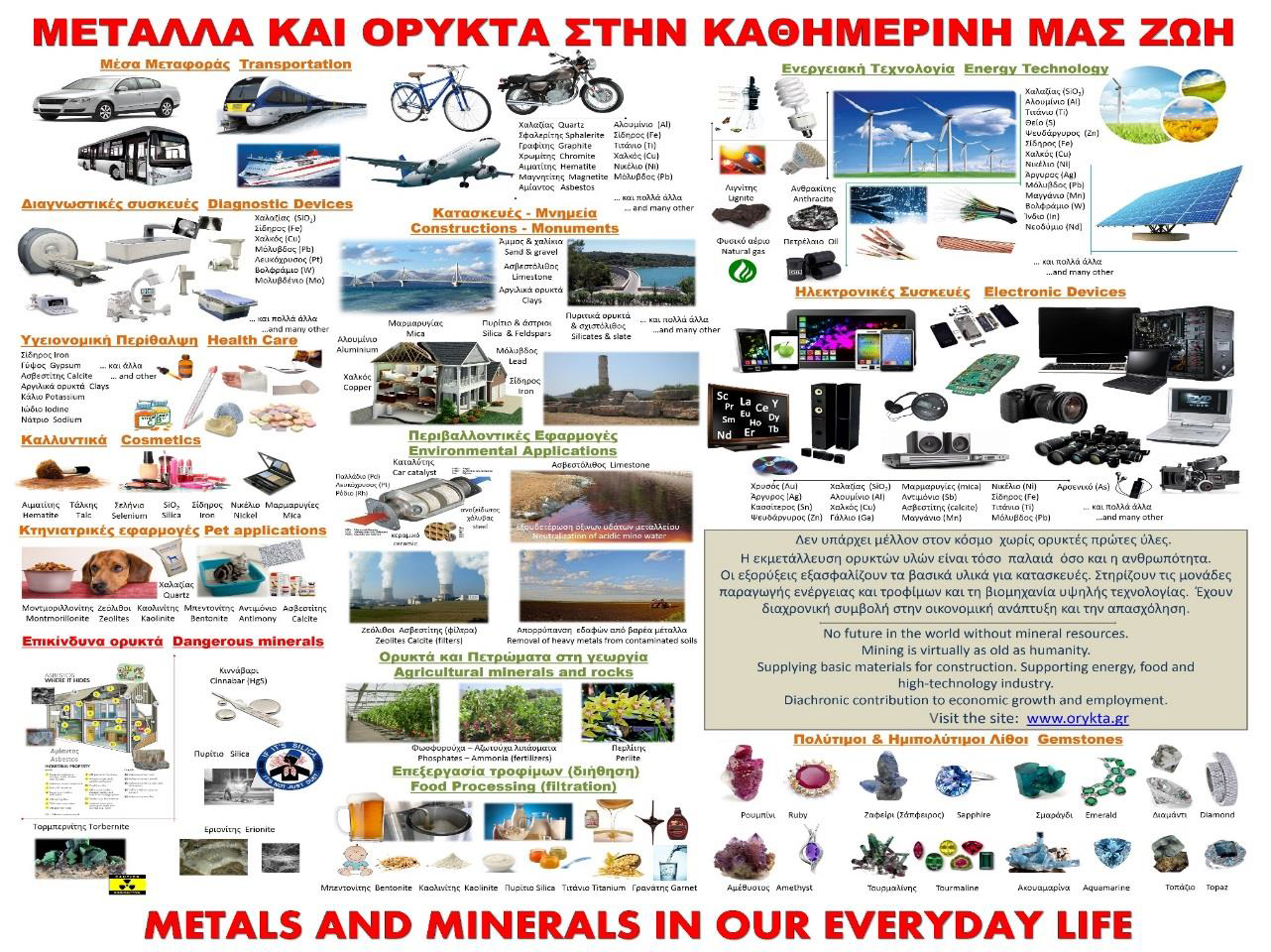
 Turning on the electric light switch in the morning, for example, we need to use copper and aluminium products, whereas, for coffee drinking, we use pots made of silica sand or feldspar. Taking a shower requires water supply pipes often made by copper, iron, nickel and chromium. Brushing our teeth with the toothpaste we use calcium carbonate, phosphate, gypsum, fluorite and dolomite. The car we drive on our way to work is composed of many different components that were manufactured from minerals. The tires use calcium carbonate and clay. All the glassy parts are made from silica sand and feldspar. The engine is made out of iron, lead, molybdenum, chromium, nickel and zinc. Getting to the office and turning on the computer we use products manufactured from gold, silica, nickel, aluminium, zinc, iron and thirty other metals, all derived from minerals. When coming home in the evening, by warming up our meal we use the microwave oven made from silica, copper, gold, iron and nickel. We enjoy our refreshments in a glass or ceramic mug of silica, calcium carbonate and feldspar, watching at the same time the television made of components using silica, iron, copper, aluminium and nickel.
Turning on the electric light switch in the morning, for example, we need to use copper and aluminium products, whereas, for coffee drinking, we use pots made of silica sand or feldspar. Taking a shower requires water supply pipes often made by copper, iron, nickel and chromium. Brushing our teeth with the toothpaste we use calcium carbonate, phosphate, gypsum, fluorite and dolomite. The car we drive on our way to work is composed of many different components that were manufactured from minerals. The tires use calcium carbonate and clay. All the glassy parts are made from silica sand and feldspar. The engine is made out of iron, lead, molybdenum, chromium, nickel and zinc. Getting to the office and turning on the computer we use products manufactured from gold, silica, nickel, aluminium, zinc, iron and thirty other metals, all derived from minerals. When coming home in the evening, by warming up our meal we use the microwave oven made from silica, copper, gold, iron and nickel. We enjoy our refreshments in a glass or ceramic mug of silica, calcium carbonate and feldspar, watching at the same time the television made of components using silica, iron, copper, aluminium and nickel.
What are minerals?
Minerals are naturally occurring substances that have distinctive chemical and physical properties. They are the building blocks of all rocks that form the Earth. There are more than 4500 recognised minerals; some are very common whereas others are uncommon. Many minerals are used in society in a wide range of applications like construction, manufacturing, agriculture and energy supply. These minerals are called economic minerals. Minerals are commonly distributed in the Earth’s crust in small amounts. But when they are found insufficient concentrations and insufficient volumes they may form economically valuable resources, known as mineral deposits. These have formed by geological processes throughout Earth’s history. In some places, e.g. at the mid-oceanic spreading ridges and near subduction zones, deposits with economic minerals are still being formed today.

Types of economic minerals
There are two main categories of minerals, Energy and Non-Energy Minerals (NEM). In the context of this work and in line with the European Raw Materials Initiative, the non-energy minerals have been subdivided into three groups: metallic minerals, industrial minerals and construction minerals.
Metallic minerals are the normal sources of metals which have a wide variety of uses. For example, iron (as steel) is used in cars or for frames of buildings, copper is used in electrical wiring, nickel is used in jet engines and aluminium is used in aircraft and to make drink cans. Precious metals, such as gold, are used in jewellery and electronics, e.g. mobile phones and flat screens.
Construction minerals, and rocks and sediments they form, include sand and gravel, brick clay, crushed rock aggregates and recycled aggregates. Construction minerals are normally produced in large quantities and used in the manufacture of concrete, bricks and pipes and in the building of houses and roads.
